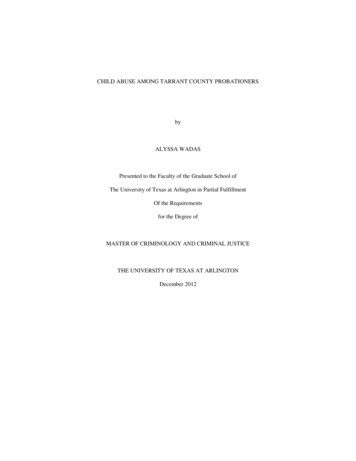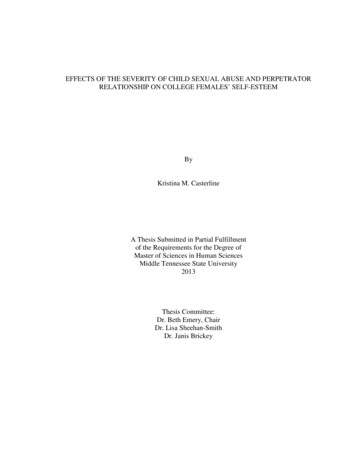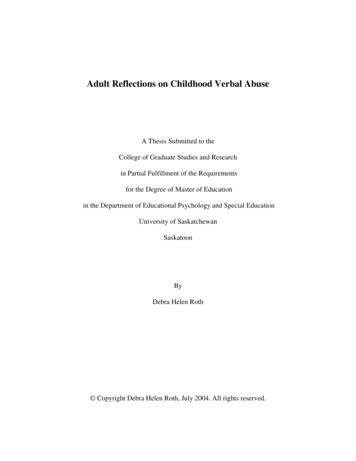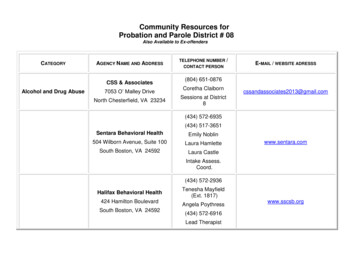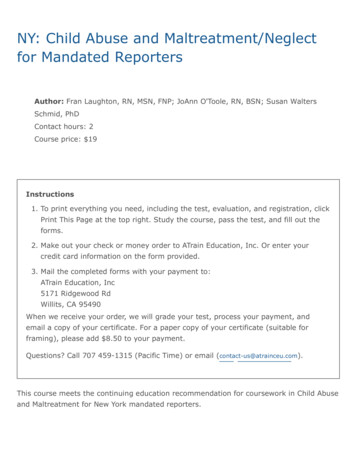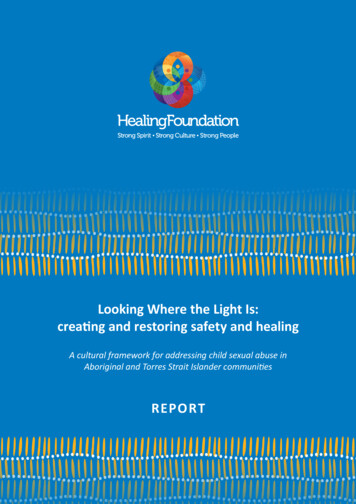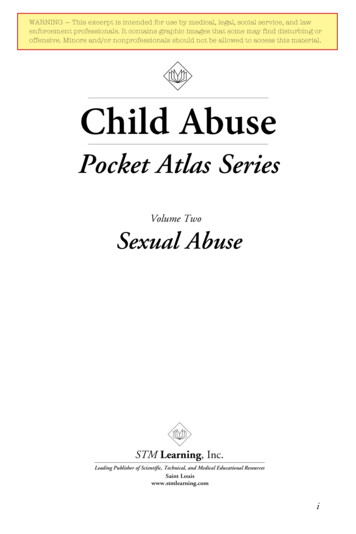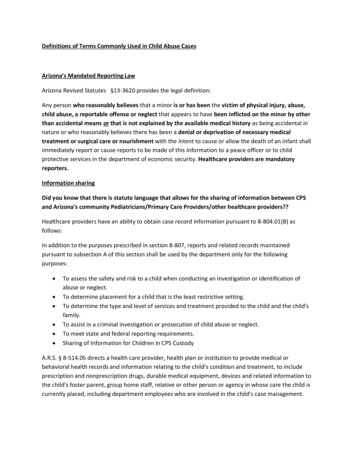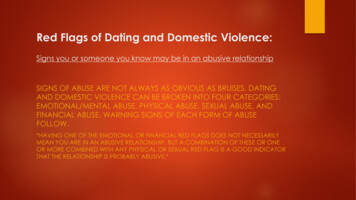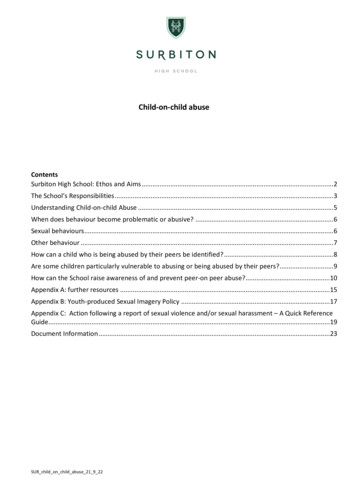
Transcription
Child-on-child abuseContentsSurbiton High School: Ethos and Aims .2The School’s Responsibilities .3Understanding Child-on-child Abuse .5When does behaviour become problematic or abusive? .6Sexual behaviours.6Other behaviour .7How can a child who is being abused by their peers be identified? .8Are some children particularly vulnerable to abusing or being abused by their peers? .9How can the School raise awareness of and prevent peer-on peer abuse?.10Appendix A: further resources .15Appendix B: Youth-produced Sexual Imagery Policy .17Appendix C: Action following a report of sexual violence and/or sexual harassment – A Quick ReferenceGuide.19Document Information .23SUR child on child abuse 21 9 22
Surbiton High School: Ethos and AimsSurbiton High School aims to inspire, encourage and empower our young people to discover and embrace theirindividuality in an intellectually rigorous academic environment. Balanced with outstanding pastoral care, ourstudents become compassionate, respectful, courageous, and inquisitive members of the community, living outthe School’s motto: Amor nos semper ducat (May love always lead us).Our ValuesWe are compassionate:We are kind and we care, in both thought and action. We consider those less fortunate and strive to support andoffer aid. We are mindful of the gentle power of positive actions. We support and encourage those around us.We are respectful:We respect all people equally. We respect ourselves, our learning, our community, our environment, andthe planet we all share. We strive to act with respect and integrity in all things. When we disagree, we do sorespectfully.We are courageous:When challenged by our fears we are determined, not deterred. We call on resilience for strength when in theheat of the struggle. We bravely chase our dreams and fight for what we believe. When we fall, we pick ourselvesup and forge forward.We are inquisitive:We understand that a thoughtful question is the key to unlock understanding. We believe where answers provideends, questions pose exciting beginnings. We are eager to explore, we question to discover, we are curious tolearn more of the world at large.We are a community:We are united - with a common focus. We value belonging to a wider community: our school community, our localcommunity, our global community. We are inclusive of all, no matter our differences. We value and nurture theconnections we form.We achieve these aims through our Charter for Happiness and Well-being. Our pupils: are inspired to deploy their highest strengths to tackle all situations, developing a growth mind-set and acan-do attitude, equipped with the tools to maximise their positive emotions are encouraged to find their niche, to be fully engaged in educational activities and to meet the highestchallenges that come their way are coached and encouraged to develop strong relationships, to be empathetic and responsive to theneeds of themselves and others are empowered to lead a meaningful life, to be able to understand what their goals are and to know whatthey are striving for are empowered to draw strength from celebrating their accomplishments, in order to tackle newchallengesSUR child on child abuse 21 9 22
We achieve these aims through our inculcation of Learning Habits. Our children: are inspired in their thinking, to ask questions, to make connections, to imagine possibilities, to reasonmethodically and to capitalise on their resources are encouraged to be emotionally invested in their learning, persevering in the face of difficulties,noticing subtle differences and patterns, managing their distractions, and becoming absorbed in theirlearning are empowered to be fully involved in their learning, growing in interdependence, collaboratingeffectively, listening empathetically to others, and imitating their learning habits are inspired, encouraged, and empowered to be productive, planning their learning in advance, revisingand reviewing their progress, distilling important information, and developing their own meta-learningUnited Learning and the United Church Schools’ TrustSurbiton High School is part of United Learning and the United Church Schools’ Trust. The School has an Anglicanfoundation, valuing its Christian heritage whilst welcoming staff and children from all faiths and none. We sharewith United Learning its core mission statement “to bring out the best in everyone”. We are committed to theaims of United Learning, including its Framework for Excellence, which can be found at:www.unitedlearning.org.ukThe School’s ResponsibilitiesIntroductionThe Governors, Senior Leadership Team, and all staff and volunteers at Surbiton High School are committed tothe prevention, early identification and appropriate management of child-on-child abuse (as defined below) bothwithin and beyond the School.This policy is designed to provide background information regarding ‘Child-on-child’ abuse and inform Schoolpractice.Surbiton High School: believes that to protect children, all schools should:(a) be aware of the level and nature of risk to which their pupils are or may be exposed, and put inplace a clear and comprehensive strategy which is tailored to their specific safeguarding context;and(b) take a contextual whole-school approach to preventing and responding to child-on-child abuseregards the introduction of this policy as a preventative measure and does not feel it is acceptablemerely to take a reactive approach to child-on-child abuse in response to alleged incidents of it.recognises national and increasing concern about this issue and wishes to implement this policy toensure that our pupils are safe.staff understand the importance of challenging inappropriate behaviours between peers, that areactually abusive in nature. Downplaying certain behaviours, for example dismissing sexual harassmentas “just banter”, “just having a laugh”, “part of growing up” or “boys being boys” can lead to a culture ofSUR child on child abuse 21 9 22
unacceptable behaviours, an unsafe environment for children and in worst case scenarios a culture thatnormalises abuse leading to children accepting it as normal and not coming forward to report it.This policy: sets out our strategy for preventing, identifying and appropriately managing child-on-child abuse.applies to all staff including teaching and non-teaching staff.is reviewed annually, and updated in the interim, as may be required, to ensure that it continually addressesthe risks to which pupils are or may be exposed.is the School's overarching policy for any issue that could constitute child-on-child abuse. It relates to, andshould be read in conjunction with the following school policies: Anti-Bullying Policy Behaviour and Discipline Policy Code of Conduct - pupils Mobile Digital Devices Policy Safeguarding and Child Protection Policy It should also be read in conjunction with KCSIE (September 2022)does not use the term ‘victim’ and/or ‘perpetrator’. This is because our School takes a safeguardingapproach to all individuals involved in allegations of or concerns about child-on-child abuse, includingthose who are alleged to have been abused and those who are alleged to have abused their peers.acknowledges that research has shown that many children who present with harmful behaviour towardsothers, in the context of child-on-child abuse, are themselves vulnerable and may have been victimisedby peers, parents or adults in the community prior to their abuse of peers 1;uses the terms 'child' and 'children', which is defined for the purposes of this policy as a person aged under18 2. We have nonetheless chosen not to restrict our approach to child-on-child abuse under this policy tochildren but instead to adopt a wider interpretation of our safeguarding responsibilities so that they apply toall pupils, regardless of age.Although the starting point is that the School's response to child-on-child abuse should be the same for all pupils,regardless of age, there may be some additional considerations in relation to a pupil aged 18 or over in terms ofhow local agencies and/or partners respond.Similarly, the School's response to incidents involving the exchange of youth-produced sexual imagery will need todiffer depending on the age of the pupils involved – see Appendix B for further information.There is also likely to be a more significant criminal justice response in relation to any pupil responsible for abusewho is aged 18 or over is compliant with the statutory guidance on child-on-child abuse as set out in KeepingChildren Safe in Education (September -research-report.pdf (see section 5)2The United Nations Convention on the Rights of the Child (1989) (ratified by the UK in 1991); the Children Act (1989); andDepartment for Education, Keeping Children Safe in Education: Statutory guidance for schools and colleges (September 2016)all define "child" as a person aged under 18.SUR child on child abuse 21 9 22
Understanding Child-on-child AbuseAll staff should be aware that children can abuse other children (often referred to as child-on-child abuse). Andthat it can happen both inside and outside of school and online. It is important that all staff recognise theindicators and signs of child-on-child abuse and know how to identify it and respond to reports.What is child-on-child abuse?For these purposes, child-on-child abuse is any form of physical, sexual, emotional and financial abuse, andcoercive control, exercised between children and within children's relationships (both intimate and nonintimate)3.Peer on peer abuse is most likely to include, but may not be limited to: bullying (including cyberbullying, prejudice-based and discriminatory bullying);abuse in intimate personal relationships between peers;physical abuse such as hitting, kicking, shaking, biting, hair pulling, or otherwise causing physical harm(this may include an online element which facilitates, threatens and/or encourages physical abuse);sexual violence, such as rape, assault by penetration and sexual assault; (this may include an onlineelement which facilitates, threatens and/or encourages sexual violence);sexual harassment, such as sexual comments, remarks, jokes and online sexual harassment, which maybe standalone or part of a broader pattern of abuse;causing someone to engage in sexual activity without consent, such as forcing someone to strip, touchthemselves sexually, or to engage in sexual activity with a third party;consensual and non-consensual sharing of nude and semi-nude images and/or videos (also known assexting or youth produced sexual imagery);upskirting, which typically involves taking a picture under a person’s clothing without their permission,with the intention of viewing their genitals or buttocks to obtain sexual gratification, or cause the victimhumiliation, distress or alarm; and initiation/hazing type violence and rituals (this could include activitiesinvolving harassment, abuse or humiliation used as a way of initiating a person into a group and may alsoinclude an online element).These types of abuse rarely take place in isolation and often indicate wider safeguarding concerns. For example, ateenage girl may be in a sexually exploitative relationship with a teenage boy who is himself being physicallyabused by a family member or by older boys. Equally, sexual bullying in schools and other settings can result in thesexual exploitation of children by their peers. For 16- and 17-year-olds who are in abusive relationships, what mayappear to be a case of domestic violence may also involve sexual exploitation.Children's experiences of abuse and violence are rarely isolated events, and they can often be linked to otherthings that are happening in their lives and spaces in which they spend their time. Any response to child-on-childabuse therefore needs to consider the range of possible types of child-on-child abuse set out above and capturethe full context of children's experiences. This can be done by adopting a Contextual Safeguarding approach andby ensuring that our response to incidents of child-on-child abuse takes into account any potential complexity.SUR child on child abuse 21 9 22
What is contextual safeguarding?This policy encapsulates a Contextual Safeguarding approach, which: is an approach to safeguarding children that recognises their experiences of significant harm in extra-familial contexts, and seeks to include these contexts within prevention, identification, assessmentand intervention safeguarding activities 3 recognises that as children enter adolescence, they spend increasing amounts of time outside of thehome in public environments (including on the internet) within which they may experience abuse;and considers interventions to change the systems or social conditions of the environments in whichabuse has occurred. For example, rather than move a child from a school, professionals could workwith the school leadership and student body to challenge harmful, gendered school cultures, thusimproving the pre-existing school environment.When does behaviour become problematic or abusive?All behaviour takes place on a spectrum. Understanding where a child's behaviour falls on a spectrum is essentialto being able to respond appropriately to it.Sexual behavioursAs the National Society for the Prevention of Cruelty to Children (NSPCC) explains “children's sexual behavioursexist on a wide continuum, from normal and developmentally expected to highly abnormal and abusive. Staffshould recognise the importance of distinguishing between problematic and abusive sexual behaviours. As bothproblematic and abusive sexual behaviours are developmentally inappropriate and may cause developmentaldamage, a useful umbrella term is harmful sexual behaviours or HSB.” This term has been adopted widely in thefield, and is used throughout the NSPCC’s and Research in Practice's Harmful Sexual Behaviour Framework, aswell as this policy.For the purpose of the NSPCC’s and Research in Practice's Harmful Sexual Behaviour Framework, and as adoptedin this policy, harmful sexual behaviours are defined as "Sexual behaviours expressed by children that aredevelopmentally inappropriate, may be harmful towards self or others, or be abusive towards another child oradult 4.Professor Simon Hackett (Durham University) chaired the practice development subgroup which produced theOperational Framework for Children and Young People Displaying Harmful Sexual Behaviours on behalf of theNSPCC5. He proposed the following continuum model to demonstrate the range of sexual behaviours presented3Firmin, C. 2017. Abuse Between Young People: A Contextual Account. Oxon: Routledge (due to be published in ramework.pdf5Operational framework for children and young people displaying harmful sexual behaviours, London, NSPCC.SUR child on child abuse 21 9 22
by children, which may be helpful when seeking to understand a [pupil's/student's] sexual behaviour and decidinghow to respond to it.Normal Developmentallyexpected Socially acceptable Consensual,mutual,reciprocal Shared decisionmakingInappropriate Singleinstances ofinappropriatesexualbehaviour Sociallyacceptablebehaviourwithin peergroup Context forbehaviourmay beinappropriate Generallyconsensualand reciprocalProblematic Problematic andconcerningbehaviour Developmentallyunusual andsociallyunexpected No overtelements ofvictimisation Consent issuesmay be unclear May lack reciprocity orequal power May include levelsof compulsivityAbusive Victimisingintent oroutcome Includesmisuseof power Coercion andforce toensurecompliance Intrusive Informed consentlacking or notable to befreely given May includeelements ofexpressiveviolenceViolent Physically violentsexual abuse Highly intrusive Instrumentalviolence which ispsychologicallyand/or sexuallyarousing to thechild responsiblefor the behaviour SadismHackett's continuum relates exclusively to sexual behaviour and is not exhaustive. The Brook Sexual BehavioursTraffic Light Tool can also be very helpful in identifying sexual behaviours by children 6. Staff should always usetheir professional judgment and discuss any concerns with the Designated Safeguarding Lead (DSL). Where an(alleged) incident involves a report of sexually harmful behaviour, staff should consult the DfE's Advice.Other behaviourWhen dealing with other alleged behaviour which involves reports of, for example, emotional and/or physicalabuse, staff can draw on aspects of Hackett’s continuum to assess where the alleged behaviour falls on aspectrum and to decide how to respond. This could include, for example, whether it: 6is socially acceptableinvolves a single incident or has occurred over a period of timeis socially acceptable within the peer groupis problematic and concerninginvolves any overt elements of victimisation or discrimination e.g., related to race, gender, sexualorientation, physical, emotional, or intellectual vulnerabilityinvolves an element of coercion or light-tool/SUR child on child abuse 21 9 22
involves a power imbalance between the child/children allegedly responsible for the behaviour and thechild/children allegedly the subject of that powerinvolves a misuse of powerIt should be borne in mind that there are some aspects of Hackett’s continuum which may not of course berelevant or appropriate to consider in response to other alleged behaviour involving reports of other types ofabuse. For example, the issue of consent and the nuances around it, is unlikely to apply in the same way in caseswhere the alleged behaviour is reported to involve emotional and/or physical abuse, as it could in cases of allegedsexual behaviour which is reported to involve harmful sexual behaviour.In addition, the School could be required to deal with cases involving a range of alleged behaviours includingsexual behaviour, emotional, physical behaviour and digital behaviour.It should also be recognised that the same behaviour presented by different children may be understood atdifferent points on a spectrum, depending on the particular context. For example, an incident involving youthproduced sexual imagery may be inappropriate in one context, for example, when exchanged between twochildren in a consenting relationship, and abusive in another, for example, when it is (a) shared without theconsent of the child in the image; (b) produced as a result of coercion; or (c) used to pressure the child intoengaging in other sexual behaviours.Behaviour which is not abusive at first may potentially become abusive quickly or over time. Intervening early andaddressing any inappropriate behaviour which may be displayed by a child is vital, and could potentially preventtheir behaviour from progressing on a continuum to become problematic, abusive and/or violent - and ultimatelyrequiring (greater/more formal) engagement with specialist external and/or statutory agencies. For example, aphysical fight between two children may not constitute child-on-child abuse where the fight is a one-off incident,but may be abusive where the child’s/children’s behaviour subsequently deteriorates into a pattern of bullyingbehaviour and requires a safeguarding response from a multi-agency partnership – including a statutoryassessment of whether this has led, for example, to a risk of significant harm to a child.The importance of intervening early and addressing any inappropriate behaviour does not just apply on anindividual pupil basis, but could also apply across the pupil body.Behaviour generally considered inappropriate may in fact indicate emerging concerning behaviour to whichschools need to take a whole-school approach in order to prevent escalation.It will also be important to consider the wider context in which the alleged behaviour is reported to haveoccurred, and which may trigger the need for a referral. For example, some behaviour that is consideredinappropriate may be capable of being dealt with internally. However, if there are wider safeguarding concernsrelating to the child/children in question, a referral to statutory agencies may be necessary. Where the behaviourwhich is the subject of the concern(s)/allegation(s) is considered or suspected by the DSL to constitute peer-onpeer abuse, the School will follow the procedures set out below.How can a child who is being abused by their peers be identified?All staff should be alert to the well-being of pupils and to signs of abuse, and should engage with these signs, asappropriate, to determine whether they are caused by child-on-child abuse. However, staff should be mindful ofSUR child on child abuse 21 9 22
the fact that the way(s) in which children will disclose or present with behaviour(s) as a result of their experienceswill differ.Signs that a child may be suffering from child-on-child abuse can also overlap with those indicating other types ofabuse (please see “Recognising Different Types of Abuse” section of the Safeguarding and Child Protection policyfor indicators of abuse) and can include: increased absence from school or failing to attend school, disengaging from classes or struggling tocarry out school related tasks to the standard ordinarily expected;a change in friendships or relationships with older individuals or groupssigns of assault or unexplained physical injuries;experiencing difficulties with mental health and/or emotional wellbeing;becoming withdrawn and/or shy; experiencing headaches, stomach aches, anxiety and/or panic attacks;suffering from nightmares or lack of sleep or sleeping too much;broader changes in behaviour including alcohol, substance misuse or signs of self-harm;changes in appearance and/or starting to act in a way that is not appropriate for the child's age;a significant decline in performance;abusive behaviour towards others.Abuse affects children very differently. The above list is by no means exhaustive and the presence of one or moreof these signs does not necessarily indicate abuse. The behaviour that children present with will depend on theirparticular circumstances. Rather than checking behaviour against a list, staff are trained to be alert to behaviourthat might cause concerns, to think about what the behaviour might signify, to encourage children to share withthem any underlying reasons for their behaviour, and, where appropriate, to engage with their parents/carers sothat the cause(s) of their behaviour can be investigated. Where a child exhibits any behaviour that is out ofcharacter or abnormal for his/her age, staff should always consider whether an underlying concern is contributingto their behaviour (for example, whether the child is being harmed or abused by their peers) and, if so, what theconcern is and how the child can be supported going forwards.The power dynamic that can exist between children is also very important when identifying and responding totheir behaviour: in all cases of child-on-child abuse, a power imbalance will exist within the relationship. Thisinequality will not necessarily be the result of an age gap between the child responsible for the abuse and thechild being abused. It may, for example, be the result of their relative social or economic status. Equally, whilechildren who abuse may have power over those who they are abusing, they may be simultaneously powerless toothers.Are some children particularly vulnerable to abusing or being abused by their peers?Any child can be vulnerable to child-on-child abuse due to the strength of peer influence during adolescence, andstaff should be alert to signs of such abuse amongst all children. Individual and situational factors can increase achild's vulnerability to abuse by their peers. For example, an image of a child could be shared, following whichthey could become more vulnerable to child-on-child abuse due to how others now perceive them, regardless ofany characteristics which may be inherent in them and/or their family. Peer group dynamics can also play animportant role in determining a child's vulnerability to such abuse. For example, children who are more likely tofollow others and/or who are socially isolated from their peers may be more vulnerable to child-on-child abuse.SUR child on child abuse 21 9 22
Children who are questioning or exploring their sexuality may also be particularly vulnerable to abuse by theirpeers.A Whole-School ApproachAll staff should understand, that even if there are no reports in their schools or colleges it does not mean it is nothappening, it may be the case that it is just not being reported. As such it is important if staff have any concernsregarding child-on-child abuse, they should speak to a member of the Safeguarding Team.How can the School raise awareness of and prevent child-on-child abuse?School environmentThe School actively seeks to raise awareness of and prevent all forms of child-on-child abuse by: Maintaining an attitude of ‘it could happen here’ where safeguarding is concerned.; Educating all Governors, Senior Leadership Team, staff and volunteers, pupils, and parents about thisissue.This includes: training all Governors, Senior Leadership Team, staff and volunteers on the nature, prevalence and effectof child-on-child abuse, and how to prevent, identify and respond to it. This includes (a) ContextualSafeguarding; (b) the identification and classification of specific behaviours; and (c) the importance oftaking seriously all forms of child-on-child abuse (no matter how low level they may appear) and ensuringthat no form of child-on-child abuse is ever dismissed as horseplay or teasing. Training includes casestudies which the staff design themselves;educating children about the nature and prevalence of child-on-child abuse via the PSHE and the widercurriculum. For example, by addressing gender inequality in a statistics class, or by reviewing literature inan English class which addresses bullying and its effect on mental health;pupils are being told what to do if they witness or experience such abuse, the effect that it can have onthose who experience it and the possible reasons for it, including vulnerability of those who inflict suchabuse.ensuring that all child-on-child abuse issues are fed back to the School's DSL who can then monitor andadvise;challenging the attitudes that underlie such abuse (both inside and outside the classroom);creating conditions in which our pupils can aspire to and realise safe and healthy relationships;creating a culture in which our pupils feel able to share their concerns openly, in a non-judgmentalenvironment, and have them listened to; andresponding to cases of child-on-child abuse promptly and appropriately.SUR child on child abuse 21 9 22
Responding to Concerns or Allegations of Child-on-child AbuseGeneral PrinciplesIt is essential that all concerns/allegations of child-on-child abuse are handled sensitively, appropriately andpromptly. The way in which they are responded to can have a significant impact on our School environment.When managing allegations, we will: manage reports with two members of staff present (preferably one being the designated safeguardinglead or deputy. At least one member of staff will be female).reassure all victims that they are being taken seriously and that they will be supported and kept safe. Avictim should never be given the impression that they are creating a problem by reporting sexual violenceor sexual harassment. Nor should a victim ever be made to feel ashamed for making a report.include a thorough investigation of the concerns/allegations and the wider context in which they mayhave occurred (as appropriate);treat all children involved as being at potential risk - while the child allegedly responsible for the abusemay pose a significant risk of harm to other children, s/he may also have considerable unmet needs andbe at risk of harm themselves.ensure a safeguarding response is in place for both the child who has allegedly experienced the abuse,and the child who has allegedly been responsible for it, and additional sanctioning work may be requiredfor the latter;understand that the abuse may indicate wider safeguarding concerns for any of the children involved, andconsider and address the effect of wider socio-cultural contexts - such as the child's/children's peer group(both within and outside the School);
Surbiton High School aims to inspire, encourage and empower our young people to discover and embrace their individuality in an intellectually rigorous academic environment. Balanced with outstanding pastoral care, our students become compassionate, respectful, courageous, and inquisitive members of the community, living out
